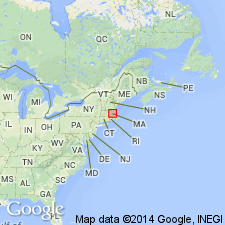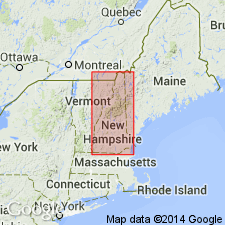
- Usage in publication:
-
- Massabesic Gneiss Complex*
- Modifications:
-
- Revised
- Age modified
- Geochronologic dating
- Areal extent
- AAPG geologic province:
-
- New England province
Summary:
Massabesic Gneiss is actually a mixed assortment of rocks that includes rocks resembling Monson Gneiss of Bronson Hill anticlinorium and rocks resembling part of Nashoba Formation of eastern MA. For this reason, the rock is here renamed Massabesic Gneiss Complex. U-Pb ages on zircons from the Massabesic range from 475 to 646 m.y. (Besancon and others, 1977; Aleinikoff and others, 1980); therefore, range is uncertain and Massabesic may contain rocks of Ordovician or Proterozoic Z age or both. Areally extended into northern MA north of main mass of Fitchburg Granite (here revised as Fitchburg Complex) in area also occupied by Permian granite, centered on Milford, NH (Aleinikoff, 1978; Aleinikoff and others, 1980).
Source: GNU records (USGS DDS-6; Reston GNULEX).

- Usage in publication:
-
- Massabesic Gneiss Complex*
- Modifications:
-
- Overview
- AAPG geologic province:
-
- New England province
Summary:
Used as Massabesic Gneiss Complex of Proterozoic Z and Ordovician age. Consists of Proterozoic Z biotite-feldspar paragneiss intruded by Ordovician potassium-feldspar-rich gneiss.
Source: GNU records (USGS DDS-6; Reston GNULEX).

- Usage in publication:
-
- Massabesic Gneiss Complex*
- Modifications:
-
- Overview
- Geochronologic dating
- AAPG geologic province:
-
- New England province
Summary:
Used as Massabesic Gneiss Complex. Occurs in southern NH. Described under both headings of "Plutonic and Associated Rocks," and "Merrimack Trough." Described as a plutonic rock consisting of pink, foliated biotite granite intruding gneissic and granulose metasedimentary and metavolcanic rocks. In Merrimack trough, consists of quartzofeldspathic gneiss (650 Ma) and biotite schists (locally rusty), granofels, and calc-silicate rocks closely intruded by, and grading into, a pink gneiss granite (475 Ma), producing a migmatite. Age changed to Late Proterozoic based on isotopic age data shown on accompanying 1:500,000-scale map, which indicates the following ages (in Ma): . 1. 620-600 U/Pb from orthogneiss(?) (Besancon and others, 1977). 2. 475 +/-? U/Pb from orthogneiss, and 646 +/-/ ? U/Pb from paragneiss (Aleinikoff and others, 1979). 3. 641 +/-25 Rb/Sr from paragneiss(?) (Kelly and others, 1980). 4. 375 +/-? U/Pb on monazite from aplite dike in Campbell Hill fault at western contact of Massabesic Gneiss [Complex] (Barbara Barreiro, oral commun., 1990). 5. 623 +/-8 U/Pb ion probe from orthogneiss; earlier 475 Ma age (Aleinikoff and others, 1979) discredited (J.N. Aleinikoff, oral commun., 1994).
Source: GNU records (USGS DDS-6; Reston GNULEX).
For more information, please contact Nancy Stamm, Geologic Names Committee Secretary.
Asterisk (*) indicates published by U.S. Geological Survey authors.
"No current usage" (†) implies that a name has been abandoned or has fallen into disuse. Former usage and, if known, replacement name given in parentheses ( ).
Slash (/) indicates name conflicts with nomenclatural guidelines (CSN, 1933; ACSN, 1961, 1970; NACSN, 1983, 2005, 2021). May be explained within brackets ([ ]).

